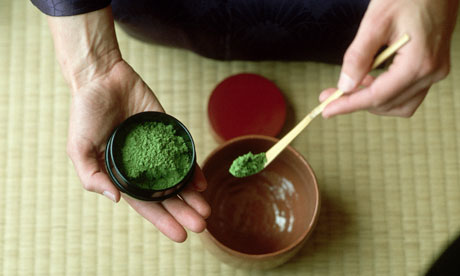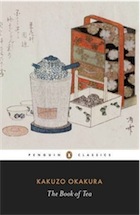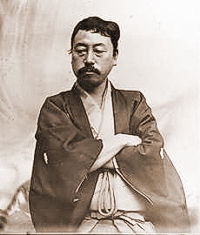 |
| preparing Japanese tea Via |
Published: 1906
It's about: In this long essay, Kakuzo Okakura discusses the history, development, and influence of the ritual of tea and the Japanese tea ceremony. He explains "Teaism," a view related to Daoism and Zennism, which draws philosophical and aesthetic meaning from the ceremony of drinking tea, promoting harmony, discipline, and enlightenment. He also discusses how Teaism is linked to art-appreciation, the architecture and interior of the Japaenese tea-house, and flower arranging.
This book was a major part of the Orientalist movement and influenced T. S. Eliot and Ezra Pound. It has also been said to be a major influence on Heidegger's concept of dasein, which he drew from Kakuzo's explaination of Zhuangzi's approach to Daoism.
Since Okakura was educated in the British tradition, this book (and all of Okakura's other works) was originally written in English. It is considered one of the English tea classics.
 I thought: I read through this little book in one setting, with a cup of this tea in hand. (Fun fact - my husband and I stayed at a Japanese spa in New Mexico for our honeymoon where this tea was served, so it brings back good memories.) The first thing I noticed it that this book demands quite a different kind of reading than a novel. I consulted wikipedia a few times to help clarify some of the Daoist concepts Okakura discussed. I also found myself linking a lot of these concepts in my head to passages I remember discussing in a class I took last year on Asian literature when we read from The Tale of Genji, especially regarding the cult of aestheticism in traditional Japanese culture. I think the importance of beauty to Japanese culture is why Okakura included a section on art appreciation, which at first glance seems a bit out of place in a book that's supposed to be about tea. This section was actually my very favorite part of this book. I especially loved the following passage, which comes after a discussion of the tea-room as a place where one can "consecrate himself to undisturbed adoration of the beautiful." Here Okakura describes the relationship between an art masterpiece and the viewer or recipient:
I thought: I read through this little book in one setting, with a cup of this tea in hand. (Fun fact - my husband and I stayed at a Japanese spa in New Mexico for our honeymoon where this tea was served, so it brings back good memories.) The first thing I noticed it that this book demands quite a different kind of reading than a novel. I consulted wikipedia a few times to help clarify some of the Daoist concepts Okakura discussed. I also found myself linking a lot of these concepts in my head to passages I remember discussing in a class I took last year on Asian literature when we read from The Tale of Genji, especially regarding the cult of aestheticism in traditional Japanese culture. I think the importance of beauty to Japanese culture is why Okakura included a section on art appreciation, which at first glance seems a bit out of place in a book that's supposed to be about tea. This section was actually my very favorite part of this book. I especially loved the following passage, which comes after a discussion of the tea-room as a place where one can "consecrate himself to undisturbed adoration of the beautiful." Here Okakura describes the relationship between an art masterpiece and the viewer or recipient:The masterpiece is a symphony played upon our finest feelings. . . . At the magic touch of the beautiful the secret chords of our being are awakened, we vibrate and thrill in response to its call. Mind speaks to mind. We listen to the unspoken, we gaze upon the unseen. The master calls forth notes we know not of. Memories long forgotten all come back to us with a new significance. Hopes stifled by fear, yearnings that we dare not recognise, stand forth in new glory. Our mind is the canvas on which the artists lay their colour; their pigments are our emotions; their chiaroscuro the light of joy, the shadow of sadness. The masterpiece is of ourselves, as we are of the masterpiece.When I first read this passage, it reminded me of one of my favorite passages from James Joyce's short story "Araby" ("My body was like a harp and her words and gestures were like fingers running upon the wires.") It also reminded me of The Tale of Genji and how it depicted emotions as beautiful in themselves, which is very different than a traditional Western approach to aesthetics. I enjoyed reading this pleasant little book. It was just long enough that the deep thinking it promoted was a delight and not a chore. I highly recommend it.
 |
| Kakuzo Okakura (via) |
Reading Recommendations: Here's a nice short article about The Book of Tea at The Guardian.
Warnings: None.
Favorite excerpts:
"There is a subtle charm in the taste of tea which makes it irresistible and capable of idealisation. Western humourists were not slow to mingle the fragrance of their thought with its aroma. It has not the arrogance of wine, the self-consciousness of coffee, nor the simpering innocence of cocoa."
"The art of life lies in a constant readjustment to our surroundings."
What I'm reading next: O Pioneers! by Willa Cather







